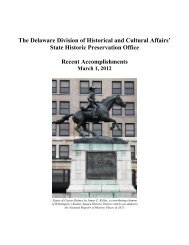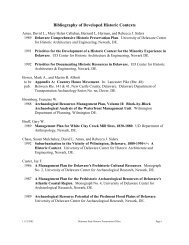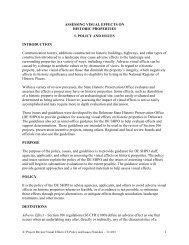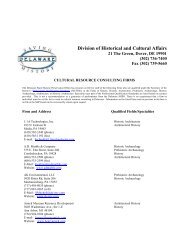Report of the Archaeological Investigations of the New Castle Court ...
Report of the Archaeological Investigations of the New Castle Court ...
Report of the Archaeological Investigations of the New Castle Court ...
Create successful ePaper yourself
Turn your PDF publications into a flip-book with our unique Google optimized e-Paper software.
NEW CASTLE COURT HOUSE PLAZA<br />
NEW CASTLE, DELAWARE<br />
5.0 INTERPRETATION AND CONCLUSIONS<br />
The artifact assemblage recovered from <strong>the</strong> investigation provides some suggestions as to how<br />
<strong>the</strong> <strong>Court</strong> House’s public space was utilized. Several classes <strong>of</strong> artifacts may be particularly<br />
indicative <strong>of</strong> public buildings and <strong>the</strong> activities associated with <strong>the</strong>ir exterior spaces. First, <strong>the</strong><br />
recovery <strong>of</strong> large numbers <strong>of</strong> straight pins from both feature and fill contexts suggests that<br />
pinning documents was a common way <strong>of</strong> providing notices at <strong>the</strong> court house. Straight pins<br />
found at public buildings are likely to represent <strong>the</strong> use <strong>of</strong> pins as paper fasteners, not items <strong>of</strong><br />
clothing. Second, <strong>the</strong> presence <strong>of</strong> tobacco pipe fragments may suggest an individual activity or<br />
pass-time on <strong>the</strong> part <strong>of</strong> court attendees. The pipes that were found were all unmarked, perhaps<br />
indicative <strong>of</strong> <strong>the</strong> sale <strong>of</strong> “generic” brand tobacco pipes during court days. Finally <strong>the</strong> food remains<br />
found in plaza contexts were similar to those observed at o<strong>the</strong>r “public” buildings and settings,<br />
such as taverns.<br />
5.5 CONCLUSION<br />
The archeological investigation conducted at <strong>the</strong> plaza <strong>of</strong> <strong>the</strong> <strong>New</strong> <strong>Castle</strong> <strong>Court</strong> House is <strong>the</strong> most<br />
recent in a series <strong>of</strong> archeological inquiries undertaken at <strong>the</strong> site spanning nearly 50 years. These<br />
projects have built upon <strong>the</strong> results and interpretations <strong>of</strong> <strong>the</strong> excavations that preceded <strong>the</strong>m,<br />
supplying historical and archeological information important to relating <strong>the</strong> story <strong>of</strong> <strong>the</strong> <strong>Court</strong><br />
House to <strong>the</strong> public. Earlier work uncovered <strong>the</strong> foundation <strong>of</strong> <strong>the</strong> first court house and tested <strong>the</strong><br />
yard and eastern plaza areas. The current work on <strong>the</strong> plaza constitutes <strong>the</strong> most intensive<br />
archeological excavation at <strong>the</strong> <strong>Court</strong> House to date and <strong>the</strong> results <strong>of</strong> that work encapsulates<br />
many <strong>of</strong> <strong>the</strong> contributions that historical archeology has to <strong>of</strong>fer. Over 7,000 artifacts were<br />
recovered and 89 archeological features were identified beneath <strong>the</strong> plaza, a ra<strong>the</strong>r remarkable<br />
discovery given <strong>the</strong> relatively small area covered by <strong>the</strong> plaza and <strong>the</strong> general construction history<br />
<strong>of</strong> <strong>the</strong> site.<br />
In <strong>the</strong> proposed Archeological Preservation Plan developed for <strong>New</strong> <strong>Castle</strong> by Louise Heite and<br />
<strong>the</strong> late Edward F. “Ned” Heite, <strong>the</strong> study area containing <strong>the</strong> <strong>Court</strong> House was considered to<br />
contain high archeological potential “both because <strong>of</strong> what is known and because <strong>of</strong> what might<br />
be found” (Heite and Heite 1989:41). The Heite’s suggested that archeological evidence <strong>of</strong><br />
prehistoric occupation <strong>of</strong> <strong>the</strong> Market Green may be present, as well as evidence <strong>of</strong> <strong>the</strong> early<br />
European settlement. The recent work at <strong>the</strong> <strong>Court</strong> House highlights <strong>the</strong> potentials enumerated by<br />
<strong>the</strong> Heites. Archeological remains <strong>of</strong> <strong>the</strong> initial fortification and public edifice on <strong>the</strong> property<br />
were documented, as were tantalizing glimpses – Native American artifacts displaced from <strong>the</strong>ir<br />
original locations and included in <strong>the</strong> plaza sands – <strong>of</strong> <strong>the</strong> pre-European occupation <strong>of</strong> <strong>the</strong> area.<br />
Evidence <strong>of</strong> heret<strong>of</strong>ore unknown or unexpected elements <strong>of</strong> <strong>the</strong> property was discovered,<br />
including a palisade trench and cellar hole dating to <strong>the</strong> first court house. We were able to study<br />
in detail <strong>the</strong> historical and physical connections among <strong>the</strong> various elements that comprise <strong>the</strong><br />
<strong>Court</strong> House. These tangible connections range from <strong>the</strong> relationship <strong>of</strong> <strong>the</strong> palisade line to <strong>the</strong><br />
stone foundation to <strong>the</strong> evidence <strong>of</strong> scaffolding to <strong>the</strong> physical changes <strong>of</strong> <strong>the</strong> court house<br />
landscape and paved plaza that exists today.<br />
88









